   |
Crankbait Walleyes… Lucky Craft Style
    |
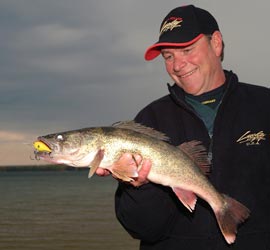 |
Walleye fishing is an interesting venture by any fishing standard. What we are talking about is a critter that loves hard bottom structure like a smallmouth bass, will thrive in grass like a largemouth bass and still live well in deep open water like a trout. For this wily predator, the successful angler needs a versatile approach, and that means crankbaits. Walleyes have always been enamored with shad shapes, preferring the slender profile with its tight wiggle to the wide wobble of more round lures. This is a little strange given there are few shad-based waters in the northern half of the continent that Walleyes consider home. However the time-tested profile of a shad-shaped lure also resembles more than shad. This profile creates an accurate illusion of many small minnows, crawfish and perhaps more importantly, small yellow perch, one of the Walleyes favorite treats. All of these features make the shad-shaped lure one of the most enduring types of lures. Strangely, it may be the tight wiggle this profile generates that may be the real story. Shad-shaped lures, like the Lucky Craft Slim Shad D-9, have the tight wiggle cold spring water requires, yet have the speed control and profile to perform all season long.
Spring Fling
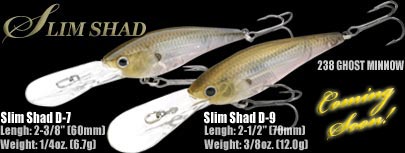 |
Walleyes streak to rocky, gravel areas to spawn; first the males soon to be followed by the females. Active in 0 to 6 feet of water, this makes for a target-rich environment for the savvy Slim Shad D-9 caster. Keep your boat in 10 feet of water or so and begin strafing the shorelines. Chuck the D-9 all the way to the bank and retrieve, pausing slightly from time to time to let the Slim Shad slowly float up before continuing your retrieve. Strikes can be as vicious as a junkyard dog or as subtle as a simple "tick." Either way, snub up the hook and enjoy the ride. Big fish are common at this time and once contact is made, fish the area thoroughly.
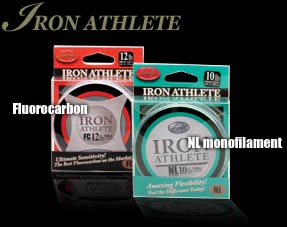 |
Combine the Slim Shad D-9 with spinning or baitcasting gear, a high quality monofilament or fluorocarbon in the 10-pound class. Lucky Craft's new Iron Athlete is the ticket. These lines will provide for long casts to cover water and achieve the running depth that makes the Slim Shad D-9 deadly.
Summer Transition
As spring moves to early summer, Walleyes remain in range for crankbaits. Moving out from spawning areas, cash-in on flats with timber or stumps. With the warming water, speedy presentations are the ticket. For shallower flats, a casting presentation is key. Contact Walleyes and then pick apart the spot-on-the-spot. Keep a sharp eye out for high spots, rock piles and other cover. For deeper post-spawn areas, trolling is a particularly effective means of finding and catching Walleyes. The Slim Shad is a trolling dream. Flat line them to cover the 8- to 15-foot zone. Combine them with snap weights or lead core line to go as deep as you need to.
Fall
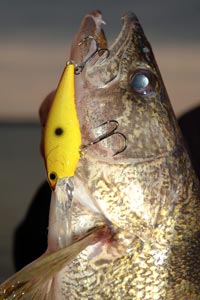 |
Fall is prime time for giant "eyes," and they respond best to hard-baits. A migration occurs in most Walleye-rich waters that is nearly as epic as in the spring. In rivers, Walleyes commonly move towards the dam in fall, following moving water to its source. In the Great Lakes, Walleyes make massive fall movements and produce some of the best trophy fishing of the year. In the cold waters of the Great Lakes in the fall, trolling is the tactic and the Slim Shad D-9 is the deal, as its tight wiggle will catch Walleyes even when water temperatures drop into the upper 30s. Watching your electronics is key, paying particular attention to the depth of baitfish and the relating Walleyes. Once determined, an angler can use any one of several trolling options to determine depth. Whenever possible, flat lining Slim Shads is easy, fun and effective. Any time the lure needs to be presented less than 20 feet deep, this is the way to go. Run your D-9 back 50 to 150 feet to achieve the desired depth and hang on. If the Walleyes are deeper, which is always a possibility in big water, incorporating weights will get the lure into the strike zone. Simply run your Slim Shad back 50 feet, attach the weight and let another 50 feet or so out. Experiment with weight, and you can dial in your Slim Shads to reach any depth. It is a fun and exciting way to catch Walleyes, especially the giant ones.
Colors
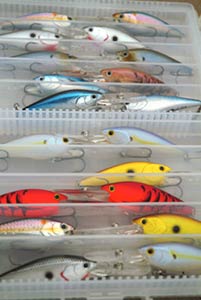 |
|
 |
Walleyes are interesting creatures in that their eyes possess unique features. The cones in their eyes allow them to see certain colors more acutely. Bright oranges, reds and chartreuses are favorites. Meeting the need of the stained-water angler, the Slim Shad is available in Japan Craw, Chartreuse Root beer and my personal favorite, Mad Craw. Some of these color traditions stem from the water color common in northern areas of the Walleye range. From the Canadian shield of Manitoba and Ontario to the Walleye-rich expanses of Minnesota and Wisconsin, much of the water is stained. Not to be confused with "dirty," stained water has the appearance of weak tea or coffee but remains quite clear. This is caused by tannic acid produced in swamps, which contributes to the watershed in these areas. Besides influencing color selection for your lures, this water color also causes the Walleyes themselves to be golden in color. In addition to enhancing certain lure colors, Walleyes eyes are lined with a material that provides them with superior night vision, allowing them to actively and successfully feed at night. This material also causes Walleyes eyes to "glow" in the dark. During the spawn, they can frequently be seen in the shallows by the eerie glow returned from a flashlights beam. This can generate one of the best night bites for Walleyes all year. A word about nighttime presentations - a straight retrieve is best. Even though Walleyes possess superb night vision, erratic presentations remain difficult to catch. Therefore a straight, steady retrieve gives the Walleyes the best shot at seeing and catching your offering.
Walleyes also inhabit the other side of the water-color spectrum. The waters that dominate some watersheds including the Great Lakes like Lake Michigan, Erie and Ontario to name a few, are clear. I don't mean kind of clear, I mean crystal clear, also known as "gin" clear. It is not unusual to be able to see the bottom in 20 to 30 feet of water. Even more surreal is this water is getting clearer as Zebra mussels continue to impact these fisheries. Zebra Mussels, an exotic species of clam, hitchhiked a ride in the ballast of some ocean-going tanker, were bilged out in Lake Ontario in the early 90s and have now completely covered the bottom of the Great Lakes in a layer of razor sharp, albeit small, clams. The "Zeb's" as we call them, filter small nutrients from the water which makes it clearer. The increased clarity also causes weed growth that aids in clearing the water. The point of all this is that clear-water Walleyes demand different lure colors than stained-water Walleyes. For that reason, Lucky Craft has produced the D-9 in clear water versions as well. Clear water colors are more translucent and natural in appearance and tend to blend in with their surroundings. The Slim Shad D-9 in Aurora Black and Original Tennessee Shad are long time favorites in these areas. Chartreuse Shad continues to be a great all-around color in any water color.
